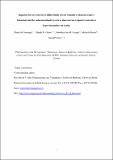| dc.contributor.author | Jennings, Elaine M. | |
| dc.contributor.author | Okine, Bright N. | |
| dc.contributor.author | Olango, Weredeselam M. | |
| dc.contributor.author | Roche, Michelle | |
| dc.contributor.author | Finn, David P. | |
| dc.date.accessioned | 2019-04-01T10:40:57Z | |
| dc.date.available | 2019-04-01T10:40:57Z | |
| dc.date.issued | 2015-05-16 | |
| dc.identifier.citation | Jennings, Elaine M., Okine, Bright N., Olango, Weredeselam M., Roche, Michelle, & Finn, David P. (2016). Repeated forced swim stress differentially affects formalin-evoked nociceptive behaviour and the endocannabinoid system in stress normo-responsive and stress hyper-responsive rat strains. Progress in Neuro-Psychopharmacology and Biological Psychiatry, 64, 181-189. doi: https://doi.org/10.1016/j.pnpbp.2015.05.008 | en_IE |
| dc.identifier.issn | 1878-4216 | |
| dc.identifier.uri | http://hdl.handle.net/10379/15084 | |
| dc.description.abstract | Repeated exposure to a homotypic stressor such as forced swimming enhances nociceptive responding in rats. However, the influence of genetic background on this stress-induced hyperalgesia is poorly understood. The aim of the present study was to compare the effects of repeated forced swim stress on nociceptive responding in Sprague-Dawley (SD) rats versus the Wistar Kyoto (WKY) rat strain, a genetic background that is susceptible to stress, negative affect and hyperalgesia. Given the well-documented role of the endocannabinoid system in stress and pain, we investigated associated alterations in endocannabinoid signalling in the dorsal horn of the spinal cord and amygdala. In SD rats, repeated forced swim stress for 10 days was associated with enhanced late phase formalin-evoked nociceptive behaviour, compared with naive, non-stressed SD controls. In contrast, WKY rats exposed to 10 days of swim stress displayed reduced late phase formalin-evoked nociceptive behaviour. Swim stress increased levels of monoacylglycerol lipase (MAGL) mRNA in the ipsilateral side of the dorsal spinal cord of SD rats, an effect not observed in WKY rats. In the amygdala, swim stress reduced anandamide (AEA) levels in the contralateral amygdala of SD rats, but not WKY rats. Additional within-strain differences in levels of CB1 receptor and fatty acid amide hydrolase (FAAH) mRNA and levels of 2-arachidonylglycerol (2-AG) were observed between the ipsilateral and contralateral sides of the dorsal horn and/or amygdala. These data indicate that the effects of repeated stress on inflammatory pain-related behaviour are different in two rat strains that differ with respect to stress responsivity and affective state and implicate the endocannabinoid system in the spinal cord and amygdala in these differences. (C) 2015 Elsevier Inc. All rights reserved. | en_IE |
| dc.description.sponsorship | This work was funded by grants from Science Foundation Ireland (10/IN.1/B2976) and the Irish Research Council. These funding agencies played no part in study design; in the collection, analysis of and interpretation data; in the writing of the report; or in the decision to submit the article for publication. | en_IE |
| dc.format | application/pdf | en_IE |
| dc.language.iso | en | en_IE |
| dc.publisher | Elsevier | en_IE |
| dc.relation.ispartof | Progress In Neuro-Psychopharmacology & Biological Psychiatry | en |
| dc.rights | Attribution-NonCommercial-NoDerivs 3.0 Ireland | |
| dc.rights.uri | https://creativecommons.org/licenses/by-nc-nd/3.0/ie/ | |
| dc.subject | Endocannabinoid | en_IE |
| dc.subject | Pain | en_IE |
| dc.subject | Sprague-Dawley | en_IE |
| dc.subject | Stress-induced hyperalgesia | en_IE |
| dc.subject | Wistar Kyoto | en_IE |
| dc.subject | FEAR-CONDITIONED ANALGESIA | en_IE |
| dc.subject | ACID AMIDE HYDROLASE | en_IE |
| dc.subject | EARLY-LIFE STRESS | en_IE |
| dc.subject | CANNABINOID RECEPTOR | en_IE |
| dc.subject | BASOLATERAL AMYGDALA | en_IE |
| dc.subject | INDUCED HYPERALGESIA | en_IE |
| dc.subject | MOLECULAR CHARACTERIZATION | en_IE |
| dc.subject | PAIN MODULATION | en_IE |
| dc.subject | CB1 RECEPTORS | en_IE |
| dc.subject | ADULT-RAT | en_IE |
| dc.title | Repeated forced swim stress differentially affects formalin-evoked nociceptive behaviour and the endocannabinoid system in stress normo-responsive and stress hyper-responsive rat strains | en_IE |
| dc.type | Article | en_IE |
| dc.date.updated | 2019-03-28T05:09:30Z | |
| dc.identifier.doi | 10.1016/j.pnpbp.2015.05.008 | |
| dc.local.publishedsource | https://doi.org/10.1016/j.pnpbp.2015.05.008 | en_IE |
| dc.description.peer-reviewed | peer-reviewed | |
| dc.contributor.funder | Science Foundation Ireland | en_IE |
| dc.contributor.funder | Irish Research Council | en_IE |
| dc.internal.rssid | 9874170 | |
| dc.local.contact | David Finn, Dept. Of Pharmacology &, Therapeutics, Nui, Galway. 5280 Email: david.finn@nuigalway.ie | |
| dc.local.copyrightchecked | Yes | |
| dc.local.version | ACCEPTED | |
| dcterms.project | info:eu-repo/grantAgreement/SFI/SFI Principal Investigator Programme (PI)/10/IN.1/B2976/IE/The role of the endocannabinoid system in anxiety-induced modulation of pain: sites and mechanisms of action/ | en_IE |
| nui.item.downloads | 404 | |


